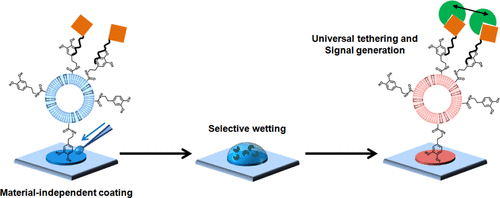当前位置:
X-MOL 学术
›
ACS Appl. Mater. Interfaces
›
论文详情
Our official English website, www.x-mol.net, welcomes your
feedback! (Note: you will need to create a separate account there.)
Mussel-Inspired Universal Bioconjugation of Polydiacetylene Liposome for Droplet-Array Biosensors
ACS Applied Materials & Interfaces ( IF 8.3 ) Pub Date : 2017-11-17 00:00:00 , DOI: 10.1021/acsami.7b14086 Do Hyun Kang 1 , Ho-Sup Jung , Keesung Kim , Jinsang Kim 1, 2
ACS Applied Materials & Interfaces ( IF 8.3 ) Pub Date : 2017-11-17 00:00:00 , DOI: 10.1021/acsami.7b14086 Do Hyun Kang 1 , Ho-Sup Jung , Keesung Kim , Jinsang Kim 1, 2
Affiliation

|
Most solid-state biosensor platforms require a specific immobilization chemistry and a bioconjugation strategy separately to tether sensory molecules to a substrate and attach specific receptors to the sensory unit, respectively. We developed a mussel-inspired universal conjugation method that enables both surface immobilization and bioconjugation at the same time. By incorporating dopamine or catechol moiety into self-signaling polydiacetylene (PDA) liposomes, we demonstrated efficient immobilization of the PDA liposomes to a wide range of substrates, without any substrate modification. Moreover, receptor molecules having a specificity toward a target molecule can also be attached to the immobilized PDA liposome layer without any chemical modification. We applied our mussel-inspired conjugation method to a droplet-array biosensor by exploiting the hydrophilic nature of PDA liposomes coated on a hydrophobic polytetrafluoroethylene surface and demonstrated selective and sensitive detection of vascular endothelial growth factor down to 10 nM.
中文翻译:

贻贝启发的聚二乙炔脂质体的通用生物共轭的液滴阵列生物传感器。
大多数固态生物传感器平台分别需要特定的固定化学方法和生物缀合策略,以将感觉分子束缚在基质上,并将特定的受体分别附着在感觉单元上。我们开发了一种以贻贝为灵感的通用结合方法,该方法可以同时进行表面固定和生物结合。通过将多巴胺或邻苯二酚部分掺入自发信号的聚二乙炔(PDA)脂质体中,我们证明了PDA脂质体可以有效地固定到各种底物上,而无需进行任何底物修饰。而且,对靶分子具有特异性的受体分子也可以不经任何化学修饰而附着于固定化的PDA脂质体层。
更新日期:2017-11-19
中文翻译:

贻贝启发的聚二乙炔脂质体的通用生物共轭的液滴阵列生物传感器。
大多数固态生物传感器平台分别需要特定的固定化学方法和生物缀合策略,以将感觉分子束缚在基质上,并将特定的受体分别附着在感觉单元上。我们开发了一种以贻贝为灵感的通用结合方法,该方法可以同时进行表面固定和生物结合。通过将多巴胺或邻苯二酚部分掺入自发信号的聚二乙炔(PDA)脂质体中,我们证明了PDA脂质体可以有效地固定到各种底物上,而无需进行任何底物修饰。而且,对靶分子具有特异性的受体分子也可以不经任何化学修饰而附着于固定化的PDA脂质体层。










































 京公网安备 11010802027423号
京公网安备 11010802027423号